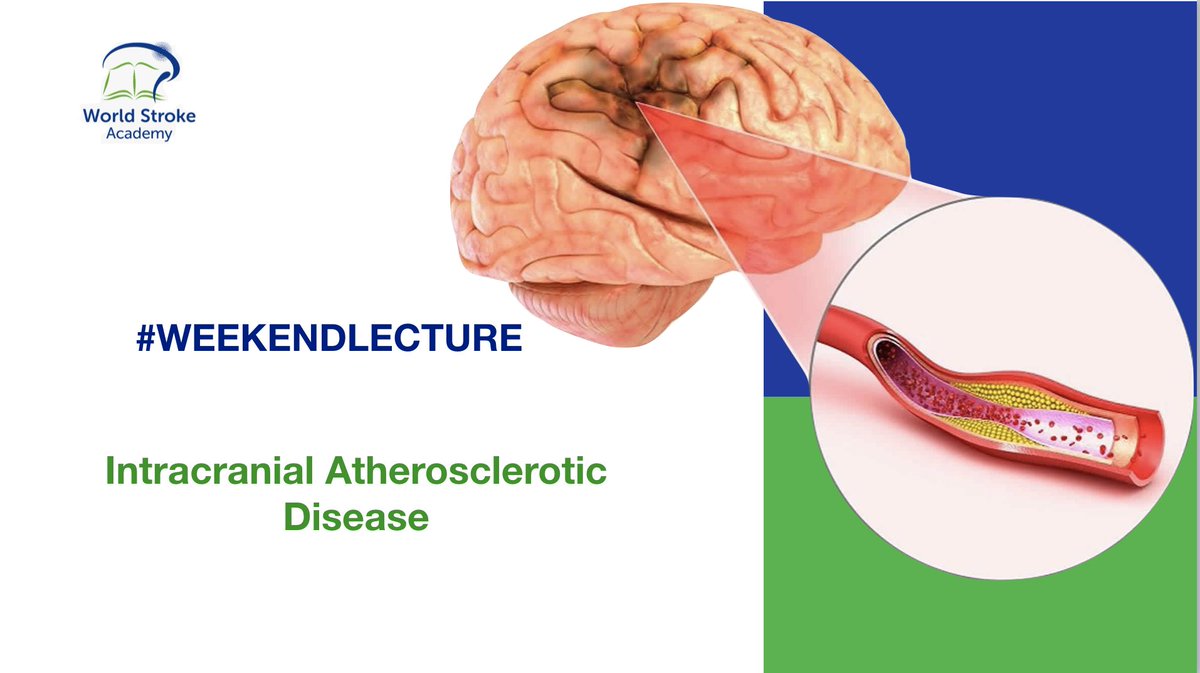#WeekendLecture
#CarotidArteryDisease #CAD
#CAD causes ~ 10-20% of #strokes
Atherosclerosis occurs most frequently at carotid #bifurcation, an area of low vessel-wall shear stress and oscillatory/turbulent blood flow
Welcome to this mini review!
#CarotidArteryDisease #CAD
#CAD causes ~ 10-20% of #strokes
Atherosclerosis occurs most frequently at carotid #bifurcation, an area of low vessel-wall shear stress and oscillatory/turbulent blood flow
Welcome to this mini review!

#WeekendLecture
#CAD
Endothelial dysfunction
⬇️
Inflammatory response to Lp retention in arterial wall
⬇️
Accelerated accumulation of Lp in subendothelial matrix
⬇️
Macrophages
⬇️
VSCM migrate/proliferate to fibroblast-like cells👉 production of EC matrix
atm.amegroups.com/article/view/7…
#CAD
Endothelial dysfunction
⬇️
Inflammatory response to Lp retention in arterial wall
⬇️
Accelerated accumulation of Lp in subendothelial matrix
⬇️
Macrophages
⬇️
VSCM migrate/proliferate to fibroblast-like cells👉 production of EC matrix
atm.amegroups.com/article/view/7…

#WeekendLecture
#CAD
Stroke Mechanisms
✅#artery_to_artery embolization: retinal (amaurosis fugax) or cerebral circulation
✅#thrombosis in situ
✅#Flow reduction in high grade stenosis: #watershed infarcts, repetitive and brief TIAs (ie limb shaking)
nejm.org/doi/full/10.10…
#CAD
Stroke Mechanisms
✅#artery_to_artery embolization: retinal (amaurosis fugax) or cerebral circulation
✅#thrombosis in situ
✅#Flow reduction in high grade stenosis: #watershed infarcts, repetitive and brief TIAs (ie limb shaking)
nejm.org/doi/full/10.10…

#WeekendLecture
#CAD
Carotid stenosis can be diagnosed using certain non- invasive modalities including
#duplex ultrasound jvascsurg.org/article/S0741-…
#CTA ahajournals.org/doi/full/10.11…
#MRA sciencedirect.com/science/articl…
Digital subtraction #angiography is the gold #standard modality
#CAD
Carotid stenosis can be diagnosed using certain non- invasive modalities including
#duplex ultrasound jvascsurg.org/article/S0741-…
#CTA ahajournals.org/doi/full/10.11…
#MRA sciencedirect.com/science/articl…
Digital subtraction #angiography is the gold #standard modality

#WeekendLecture
#CAD
The most important information gained from imaging test is % of #stenosis
The measurement method used in the North American Symptomatic Carotid Endarterectomy Trial #NASCET is used most widely
The #ECST used different criteria
thelancet.com/journals/lance…
#CAD
The most important information gained from imaging test is % of #stenosis
The measurement method used in the North American Symptomatic Carotid Endarterectomy Trial #NASCET is used most widely
The #ECST used different criteria
thelancet.com/journals/lance…

#WeekendLecture
#CAD
#NASCET👉#CEA for preventing stroke in symptomatic patients w/ TIAs/minor strokes
✅ARR 17% for ipsilateral stroke in high-grade 70–99% stenosis
👉ARR 7.8% if 50-69%
No benefit for stenosis <50%
#ECST & #VACS provided similar results
nejm.org/doi/full/10.10…

#CAD
#NASCET👉#CEA for preventing stroke in symptomatic patients w/ TIAs/minor strokes
✅ARR 17% for ipsilateral stroke in high-grade 70–99% stenosis
👉ARR 7.8% if 50-69%
No benefit for stenosis <50%
#ECST & #VACS provided similar results
nejm.org/doi/full/10.10…


#WeekendLecture
#CAD
Based on a pool analysis from #NASCET and #ECST, Rothwell & cols from CETC found that benefit from #endarterectomy depends not only on the degree of carotid stenosis, and was greatest in:
👉Men
👉>75yo
👉<2 weeks after ischemic event
thelancet.com/journals/lance…
#CAD
Based on a pool analysis from #NASCET and #ECST, Rothwell & cols from CETC found that benefit from #endarterectomy depends not only on the degree of carotid stenosis, and was greatest in:
👉Men
👉>75yo
👉<2 weeks after ischemic event
thelancet.com/journals/lance…

#WeekendLecture
#CAD
Carotid artery #stenting was introduced as a less invasive treatment alternative
In #symptomatic stenosis, CAS showed higher risk of stroke/death within 30d vs CEA
Beyond 30d, CAS is as #effective in preventing recurrent stroke as CEA
ahajournals.org/doi/10.1161/ST…
#CAD
Carotid artery #stenting was introduced as a less invasive treatment alternative
In #symptomatic stenosis, CAS showed higher risk of stroke/death within 30d vs CEA
Beyond 30d, CAS is as #effective in preventing recurrent stroke as CEA
ahajournals.org/doi/10.1161/ST…

#WeekendLecture
#CAD
The risk of ischemic stroke is determined not only by the degree of vessel stenosis but also by plaque morphology
👉ahajournals.org/doi/10.1161/ST…
Advances in carotid imaging look for signs of plaque #vulnerability
#unstable
👉thejns.org/view/journals/…


#CAD
The risk of ischemic stroke is determined not only by the degree of vessel stenosis but also by plaque morphology
👉ahajournals.org/doi/10.1161/ST…
Advances in carotid imaging look for signs of plaque #vulnerability
#unstable
👉thejns.org/view/journals/…



#WeekendLecture
#CAD
☝️It is very important to recognize that patients with symptomatic CAD should not only be evaluated for CEA/CAS.
✅Medical management has improved to a large extent in:
👉Antiplatelets
👉Lipid management
👉Other RFs: HTN,DM, smoking
link.springer.com/article/10.100…
#CAD
☝️It is very important to recognize that patients with symptomatic CAD should not only be evaluated for CEA/CAS.
✅Medical management has improved to a large extent in:
👉Antiplatelets
👉Lipid management
👉Other RFs: HTN,DM, smoking
link.springer.com/article/10.100…
#WeekendLecture
#CAD
Advances in #medical management
✅antiplatelet therapy
✅high-potency statin use
✅targeted BP treatment
✅lifestyle modification
are currently being evaluated in #asymptomatic patients vs #revascularization in @CREST2_Study and #ECST2
journals.sagepub.com/doi/10.1177/17…
#CAD
Advances in #medical management
✅antiplatelet therapy
✅high-potency statin use
✅targeted BP treatment
✅lifestyle modification
are currently being evaluated in #asymptomatic patients vs #revascularization in @CREST2_Study and #ECST2
journals.sagepub.com/doi/10.1177/17…

#WeekendLecture
#CAD
@vhnavia @VascularFleni @IST_3 @ESOstroke @ECSandset @pablolavados @SharashidzeVera @Jan_FriSch @cheryl_carcel @Teddyyhwu @ShadiYaghi2 @maramd @shazamhussain @JimSiegler @DanielVelaMD @neuropuc @Montecoya @carlosmictusvh @BoNorrving @MiamiNeuroRes
#CAD
@vhnavia @VascularFleni @IST_3 @ESOstroke @ECSandset @pablolavados @SharashidzeVera @Jan_FriSch @cheryl_carcel @Teddyyhwu @ShadiYaghi2 @maramd @shazamhussain @JimSiegler @DanielVelaMD @neuropuc @Montecoya @carlosmictusvh @BoNorrving @MiamiNeuroRes
• • •
Missing some Tweet in this thread? You can try to
force a refresh



























